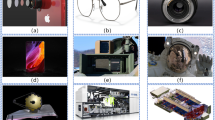Abstract
At present, the error control process of the complex thin-walled workpiece mainly adopts the error suppression and error elimination; the effectiveness of error control depends on the cognition of the process designer about machine accuracy and the error-generating mechanism. This paper proposes a new compensation method to control errors in machining thin-walled workpieces based on the inverse reconstruction model. In this method, the thin-walled workpiece is represented by discrete point cloud (DPC) for error analysis; according to the unified error prediction model, the DPC positions can be obtained companying with the machining errors. Then the new DPC is reconstructed into the workpiece model used inverse reconstruction model. At the same time, a fairing algorithm is developed to deal with the smoothing problem of DPC. So, the new workpiece model is used instead of the original for processing. By this method, the machining precision and surface quality of thin-walled workpieces are ensured. In addition, a case study is presented to demonstrate the effectiveness of the method.
Similar content being viewed by others
References
Haiyan Deng SNM (2006) Determination of minimum clamping forces for dynamically stable fixturing. Int J Mach Tool Manu 46(7-8):847–857. https://doi.org/10.1016/j.ijmachtools.2005.07.040
Anand Raghu SNM (2004) Analysis of the effects of fixture clamping sequence on part location errors. Int J Mach Tool Manu 44(4):373–382. https://doi.org/10.1016/j.ijmachtools.2003.10.015
Wan X-J, Zhang Y, Huang X-D (2013) Investigation of influence of fixture layout on dynamic response of thin-wall multi-framed workpiece in machining. Int J Mach Tool Manu 75:87–99
Vasundara M, Padmanaban KP (2014) Recent developments on machining fixture layout design, analysis, and optimization using finite element method and evolutionary techniques. Int J Adv Manuf Technol 70(1–4):79–96. https://doi.org/10.1007/s00170-013-5249-6
Tsai MY, Chang SY, Hung JP, Wang CC (2016) Investigation of milling cutting forces and cutting coefficient for aluminum 6060-T6. Comput Electr Eng 51(4):320–330. https://doi.org/10.1016/j.compeleceng.2015.09.016
Kara ME, Budak E (2015) Optimization of turn-milling processes. Procedia CIRP 33:476–483. https://doi.org/10.1016/j.procir.2015.06.057
Durakbasa MN, Akdogan A, Vanli AS, Bulutsuz AG (2015) Optimization of end milling parameters and determination of the effects of edge profile for high surface quality of AISI H13 steel by using precise and fast measurements. Measurement 68:92–99. https://doi.org/10.1016/j.measurement.2015.02.042
Wang J, Ibaraki S, Matsubara A (2017) A cutting sequence optimization algorithm to reduce the workpiece deformation in thin-wall machining. Precis Eng 50:506–514. https://doi.org/10.1016/j.precisioneng.2017.07.006
Lee HC, Hong SY, Hong CS, Park K, Kim D-S (2007) Analytic and discrete fairing of three-dimensional B-spline curves using nonlinear programming. Comput Ind Eng 53(2):263–269. https://doi.org/10.1016/j.cie.2007.06.019
Lamas J, Ramil A, Yañez A (2009) Smoothing and simplification algorithm for computer aided manufacturing paths with complex curves. IFAC Proc Vol 42(21):61–65. https://doi.org/10.3182/20091006-3-ES-4010.00013
Chen L, Xu K, Tang K (2017) Optimized sequence planning for multi-axis hybrid machining of complex geometries. Comput Graph. https://doi.org/10.1016/j.cag.2017.07.018
Yang J, Yuen A (2017) An analytical local corner smoothing algorithm for five-axis CNC machining. Int J Mach Tools Manuf 123:22–35. https://doi.org/10.1016/j.ijmachtools.2017.07.007
Tajima S, Sencer B (2017) Global tool-path smoothing for CNC machine tools with uninterrupted acceleration. Int J Mach Tools Manuf 121:81–95. https://doi.org/10.1016/j.ijmachtools.2017.03.002
Nojedeh MV, Habibi M, Arezoo B (2011) Tool path accuracy enhancement through geometrical error compensation. Int J Mach Tool Manu 51(6):471–482. https://doi.org/10.1016/j.ijmachtools.2011.02.005
Hu P, Chen L, Tang K (2017) Efficiency-optimal iso-planar tool path generation for five-axis finishing machining of freeform surfaces. Comput Aided Des 83:33–50. https://doi.org/10.1016/j.cad.2016.10.001
Tunc LT, Budak E, Bilgen S, Zatarain M (2016) Process simulation integrated tool axis selection for 5-axis tool path generation. CIRP Ann 65(1):381–384. https://doi.org/10.1016/j.cirp.2016.04.113
Sun Y, Sun S, Xu J, Guo D (2017) A unified method of generating tool path based on multiple vector fields for CNC machining of compound NURBS surfaces. Comput Aided Des 91:14–26. https://doi.org/10.1016/j.cad.2017.04.003
Zhang K, Tang K (2016) Optimal five-axis tool path generation algorithm based on double scalar fields for freeform surfaces. Int J Adv Manuf Technol 83(9–12):1503–1514. https://doi.org/10.1007/s00170-015-7646-5
Ma JW, Su WW, Jia ZY, Song DN, Hu GQ (2017) An optimization method of tool-path parameters for curved surface by construction of cutter location mesh units. Int J Adv Manuf Technol 3:1–10
Zuo X, Li B, Yang J, Jiang X (2013) Integrated geometric error compensation of machining processes on CNC machine tool. Procedia CIRP 8:135–140. https://doi.org/10.1016/j.procir.2013.06.078
Li B, Zuo XY, Yang J, Jiang X, Ni J (2014) Interactive influence of linked characteristics during machining of thin-walled parts. Int J Adv Manuf Technol 72(9):1727–1734. https://doi.org/10.1007/s00170-014-5797-4
Zuo X, Li B, Yang J (2016) Error sensitivity analysis and precision distribution for multi-operation machining processes based on error propagation model. Int J Adv Manuf Technol 86(1):1–12
Rodríguez JELP (2013) A new model for the prediction of cutting forces in micro-end-milling operations. J Mater Process Technol 213(2):261–268. https://doi.org/10.1016/j.jmatprotec.2012.09.009
Soori M, Arezoo B, Habibi M (2014) Virtual machining considering dimensional, geometrical and tool deflection errors in three-axis CNC milling machines. J Manuf Syst 33(4):498–507. https://doi.org/10.1016/j.jmsy.2014.04.007
José J, Abellan-Nebot V, Romero Subiro’n F (2012) Quality prediction and compensation in multi-station machining processes using sensor-basedfixtures. Robot Comput Integr Manuf 28(2):208–219. https://doi.org/10.1016/j.rcim.2011.09.001
Author information
Authors and Affiliations
Corresponding author
Rights and permissions
About this article
Cite this article
Zuo, X., Zhang, C., Li, H. et al. Error analysis and compensation in machining thin-walled workpieces based on the inverse reconstruction model. Int J Adv Manuf Technol 95, 2369–2377 (2018). https://doi.org/10.1007/s00170-017-1365-z
Received:
Accepted:
Published:
Issue Date:
DOI: https://doi.org/10.1007/s00170-017-1365-z




